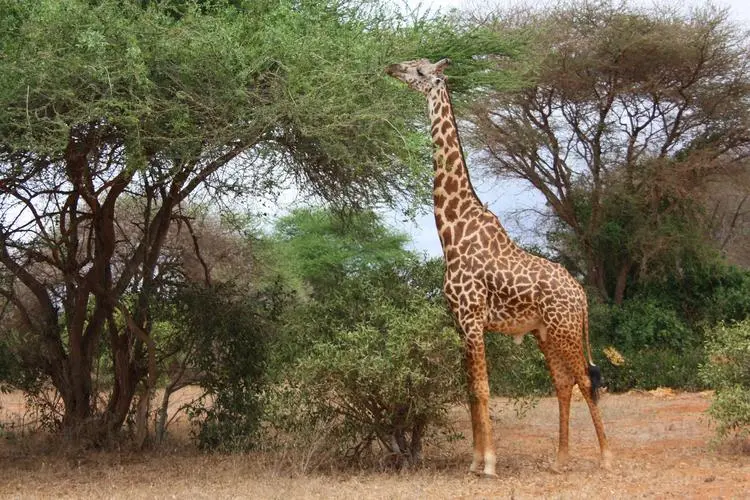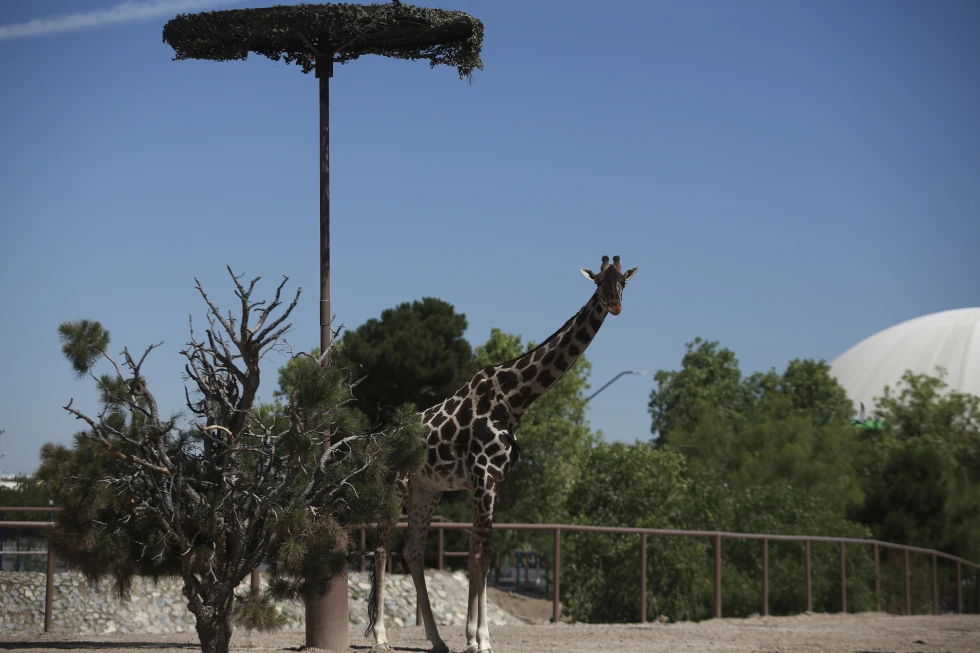The plight of Benito the giraffe in the arid northern border city of Ciudad Juarez, Mexico, has captured the attention of animal rights activists and concerned citizens alike.
Benito’s struggle against extreme temperatures and a confined enclosure has sparked a campaign to secure a more suitable and spacious habitat for this majestic creature.
This essay aims to delve into the circumstances surrounding Benito’s situation, the efforts to improve his living conditions, and the broader implications for animal welfare and conservation.
In May 2023, Benito, a 3-year-old giraffe, arrived in Ciudad Juarez, where he was confronted with the harsh realities of his environment.
The scorching desert sun and limited shade exposed him to the elements, while the winter cold and winds posed additional challenges to his well-being.
The detrimental impact of these conditions on Benito’s health and quality of life became a focal point for animal rights activists, prompting a concerted effort to advocate for his relocation to a more suitable habitat.
The campaign to save Benito was spearheaded by the group “We Are Your Voice,” led by dedicated activist Ana Félix.
Their unwavering commitment to advocating for Benito’s welfare galvanized public support and brought attention to the urgent need for action.
The group’s efforts to raise awareness, mobilize resources, and engage with relevant authorities exemplify the power of grassroots activism in championing the rights of animals.
Through their persistence and determination, they succeeded in drawing attention to Benito’s plight and demanding a better future for him.
The culmination of the advocacy campaign came with the promising commitment from officials to relocate Benito to a more spacious animal park 1,250 miles (2,000 kilometers) to the south.
This significant development represents a triumph for the advocates and a beacon of hope for Benito’s future.
The prospect of a more suitable habitat, free from the extremes of the desert climate, offers a glimmer of optimism for Benito’s well-being and underscores the transformative impact of collective action in effecting positive change.
Benito’s story serves as a poignant reminder of the challenges faced by captive animals and the imperative to prioritize their welfare.
It highlights the intersection of environmental factors, human intervention, and ethical considerations in the management of wildlife.
Furthermore, it underscores the interconnectedness of local and global efforts to safeguard the rights and habitats of endangered species.
By amplifying the voices of those who advocate for animals like Benito, we reaffirm our shared responsibility to protect and preserve the diversity of life on our planet.
The journey to secure a better future for Benito the giraffe is a testament to the power of advocacy, compassion, and collective action.
It underscores the capacity of individuals and communities to effect meaningful change and uphold the rights of vulnerable creatures.
As Benito prepares to embark on a new chapter in a more suitable environment, his story serves as a rallying cry for continued commitment to animal welfare and conservation.
By standing together as stewards of the natural world, we honor the intrinsic value of all living beings and endeavor to create a more compassionate and harmonious coexistence.
In conclusion, the journey of Benito the giraffe reflects the resilience of the human spirit and the enduring pursuit of justice for our fellow inhabitants of this planet.
The recent decision by the government of the northern state of Chihuahua to transfer Benito, a giraffe, to the Africam Safari park in the central state of Puebla has sparked significant public interest and debate.
This move has been prompted by concerns over the well-being of Benito, as highlighted by activists and animal welfare advocates.
The decision to transfer Benito comes after mounting pressure from social media campaigns and the intervention of the Attorney General’s Office for Environmental Protection (Profepa).
This essay aims to critically examine the implications of this decision, the broader context of animal welfare, and the complexities involved in the transfer of large animals across the country.
Africam Safari, renowned for its safari-style park where animals roam large enclosures while visitors observe from their cars, has agreed to receive Benito.
This decision is a significant step towards addressing the concerns raised by activists and ensuring the well-being of the giraffe.
The confirmation of the transfer by the Chihuahua government underscores the recognition that the welfare of animals under human care is a matter of utmost importance.
It also reflects a growing awareness of the ethical and moral responsibilities associated with the treatment of animals in captivity.
The delay in taking action regarding Benito’s transfer, as highlighted by activists, raises important questions about the adequacy of existing regulations and oversight mechanisms for the protection of animals in captivity.
The case of Benito underscores the need for proactive and vigilant monitoring of animal welfare standards across all facilities that house and exhibit wildlife.
The government’s acknowledgment of the urgency of Benito’s situation, albeit belated, signals a step towards greater accountability and responsiveness to public concerns regarding animal welfare.
The transfer of Benito from Chihuahua to Puebla presents logistical challenges due to the size and nature of the giraffe.

The complexities involved in moving large animals across the country require meticulous planning and coordination to ensure the safety and well-being of the animal throughout the process.
The remarks made by Africam Safari Director Frank Carlos Camacho regarding the intricacies of moving a giraffe of Benito’s size underscore the practical considerations that must be addressed to facilitate a smooth and secure transfer.
The case of Benito also highlights broader issues pertaining to the housing and care of animals in captivity.
The conditions in which Benito was kept in Ciudad Juarez’s city-run Central Park, as described by activists, raise concerns about the adequacy of his living environment.
The small fenced enclosure, limited space for movement, and inadequate natural elements such as trees for grazing all point to the need for a reevaluation of the standards and conditions under which animals are housed in captivity.
The case of Benito serves as a reminder of the ethical responsibilities associated with the maintenance and care of wildlife in captivity, and the imperative to ensure that their physical and psychological well-being is prioritized.
The decision to transfer Benito to Africam Safari represents a step towards addressing the welfare concerns raised by activists.
It also underscores the importance of public advocacy and social media campaigns in drawing attention to issues related to animal welfare.
The role of public awareness and activism in influencing policy decisions and institutional responses to animal welfare issues cannot be overstated.
The case of Benito serves as a testament to the power of public advocacy in effecting positive change for the well-being of animals.
In conclusion, the transfer of Benito the giraffe to Africam Safari Park reflects a significant development in the ongoing discourse surrounding animal welfare and the treatment of wildlife in captivity.
The decision underscores the imperative to prioritize the well-being of animals under human care and the need for robust oversight and regulatory mechanisms to ensure compliance with ethical and welfare standards.
The complexities involved in the transfer of large animals across the country also highlight the practical considerations that must be addressed to ensure the safety and welfare of the animals involved.
The case of Benito serves as a call to action for a reevaluation of the standards and conditions under which animals are housed in captivity, and the need for a collective commitment to upholding the welfare and dignity of all living beings.
As we move forward, it is essential to continue advocating for the ethical and compassionate treatment of animals, and to work towards creating environments that prioritize their physical and psychological well-being.
The case of Benito underscores the importance of public awareness, advocacy, and institutional responsiveness in safeguarding the welfare of animals, and serves as a reminder of the moral and ethical responsibilities associated with our stewardship of the natural world.
The recent developments at the park have sparked widespread interest and discussion among the public. The construction of a larger sun canopy for the giraffe, along with the removal of garbage and fetid water from a pool within the enclosure, has garnered attention and raised questions about the treatment and welfare of animals in captivity.
The impact of these changes, particularly in relation to the giraffe named Benito, has been significant, as evidenced by the increase in monthly visits from 140,000 to 200,000 following Benito’s arrival.
Benito’s journey to the park is a story that intertwines elements of conservation, animal welfare, and regional dynamics.
Donated by a zoo in Sinaloa, a state on Mexico’s northern Pacific coast, Benito’s relocation was necessitated by the presence of a territorial male giraffe at his previous habitat.
The implications of this move extend beyond the confines of the park, as it has become a source of pride for Ciudad Juarez, a city known for its industrial landscape and persistent issues with gang violence.
The significance of Benito’s presence in Central Park cannot be understated, particularly in the context of the park’s efforts to enhance its appeal to visitors, especially children.
However, amidst the attention garnered by Benito, concerns have been raised about the overall suitability of the park as a habitat for various animal species.
This has prompted calls for the rehousing of other animals, such as ducks and donkeys, by individuals like Félix, who advocate for better living conditions for these creatures.
The discourse surrounding the treatment of animals in the park raises fundamental questions about the ethical and practical considerations involved in maintaining captive animal populations within public spaces.
Félix’s statement, emphasizing the inadequacy of the park as a suitable environment for animals, underscores the broader debate surrounding the intersection of urban development, conservation, and animal rights.
The evolving narrative of Benito and the park’s animal population invites a deeper examination of the complex dynamics at play.
It prompts reflection on the responsibilities of institutions and communities in ensuring the well-being of animals under their care, as well as the broader implications for public awareness and engagement with wildlife conservation.
As the park continues to navigate these issues, it is imperative to consider the broader implications of its actions and policies on animal welfare, public perception, and environmental stewardship.
The story of Benito and the park’s animal inhabitants serves as a catalyst for broader conversations about the ethical and practical dimensions of human-animal interactions in urban settings.
In conclusion, the developments at the park, particularly in relation to Benito and the broader animal population, have sparked important conversations about the treatment and welfare of animals in public spaces.

These discussions have broader implications for urban development, conservation efforts, and societal attitudes towards wildlife.
As the park grapples with these complex issues, it is crucial to consider the ethical and practical dimensions of its actions and policies, with a focus on promoting the well-being of animals and fostering greater public awareness and engagement with wildlife conservation.
